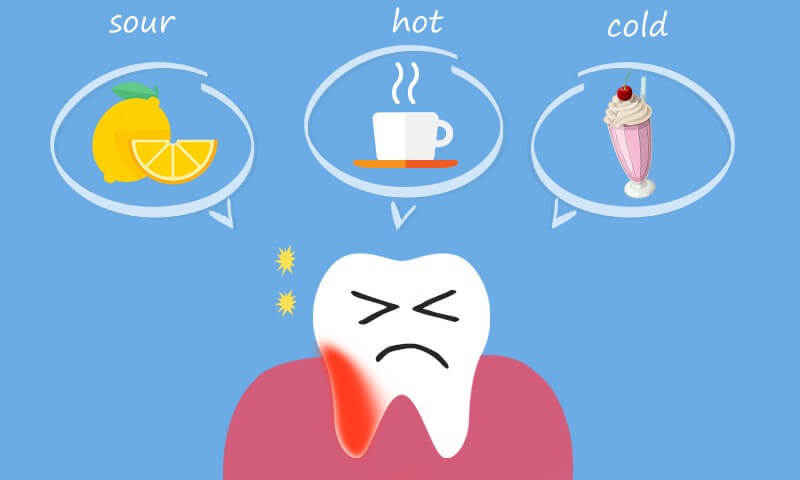How To Fix Side Of Tooth Filling Sensitivity? Expert Help

Tooth filling sensitivity, particularly on the side of a tooth, can be a significant source of discomfort for many individuals. This issue often arises after dental procedures, including fillings, and can be caused by a variety of factors. Understanding the reasons behind this sensitivity and knowing how to address it is crucial for maintaining oral health and comfort.
Causes of Side Tooth Filling Sensitivity
Before delving into the solutions, it’s essential to understand the possible causes of side tooth filling sensitivity. These include:
- Poor Filling Technique: If the filling is not properly sealed or if the technique used was suboptimal, it can lead to sensitivity.
- Shrinkage of Filling Material: Some filling materials, like composite resins, can shrink over time, creating small gaps between the filling and the tooth, which can cause sensitivity.
- Tooth Decay Under the Filling: If the decay was not fully removed before the filling was placed, it can continue to progress, leading to sensitivity.
- Gum Recession: Exposure of the roots of the teeth due to gum recession can cause sensitivity, especially on the sides of the teeth where the roots are closer to the surface.
- Cracked Tooth or Filling: A crack in the tooth or the filling can provide a pathway for bacteria to reach the pulp, causing sensitivity.
Solutions for Side Tooth Filling Sensitivity
Fortunately, there are several approaches to fixing side tooth filling sensitivity, ranging from self-care measures to professional dental interventions.
Self-Care Measures
- Desensitizing Toothpaste: Using toothpaste specifically designed for sensitivity can help block the dentinal tubules in the tooth, reducing sensitivity.
- Good Oral Hygiene: Maintaining good oral hygiene practices, such as regular brushing and flossing, can help prevent further irritation and decay.
- Avoiding Irritants: Temporarily avoiding foods and drinks that are known to trigger sensitivity, such as hot, cold, or sweet items, can help alleviate discomfort.
Professional Dental Solutions
- Re-evaluation and Repair of the Filling: A dentist can assess the filling to determine if it needs to be replaced or repaired. Improperly placed fillings can be redone, and additional decay can be removed.
- Fluoride Varnish: Applying a fluoride varnish can help strengthen tooth enamel and reduce sensitivity.
- Dental Bonding: If the sensitivity is due to a small crack or gap, dental bonding can be used to seal the area.
- Root Canal Therapy: In cases where the sensitivity is severe and indicates infection of the pulp, a root canal may be necessary to remove the infected tissue.
- Gum Graft: If gum recession is the cause of the sensitivity, a gum graft can help cover the exposed root surface, reducing sensitivity.
Preventive Measures
Preventing tooth filling sensitivity involves a combination of good oral hygiene practices, regular dental check-ups, and the use of appropriate materials and techniques during dental procedures.
- Regular Dental Check-Ups: Regular visits to the dentist can help identify and address potential issues before they become major problems.
- Use of High-Quality Materials: Dentists should use high-quality filling materials that are less likely to shrink or cause other issues.
- Proper Filling Technique: Ensuring that the filling is placed correctly, with a good seal and no gaps, can prevent future sensitivity.
Conclusion
Side tooth filling sensitivity is a common issue that can arise from various factors. While self-care measures can provide temporary relief, professional dental intervention is often necessary to address the underlying cause. By understanding the causes and seeking appropriate dental care, individuals can alleviate discomfort and maintain good oral health. Regular dental check-ups and preventive measures are key to avoiding sensitivity issues and ensuring the longevity of dental fillings.
What are the most common causes of side tooth filling sensitivity?
+The most common causes include poor filling technique, shrinkage of filling material, tooth decay under the filling, gum recession, and cracked tooth or filling.
How can I alleviate side tooth filling sensitivity at home?
+You can use desensitizing toothpaste, maintain good oral hygiene, and avoid irritants like hot, cold, or sweet foods and drinks.
When should I consult a dentist for side tooth filling sensitivity?
+You should consult a dentist if the sensitivity is severe, persists over time, or is accompanied by other symptoms like pain or swelling. A dentist can provide professional solutions like re-evaluation and repair of the filling, fluoride varnish, dental bonding, or root canal therapy.
By addressing the root cause of the sensitivity and maintaining good oral health practices, individuals can effectively manage and prevent side tooth filling sensitivity, ensuring a healthier and more comfortable smile.


